Evidence-Based Practice: Barriers and Implementation Strategies
VerifiedAdded on 2023/06/08
|11
|3036
|167
Essay
AI Summary
This essay discusses the barriers to implementing evidence-based practice (EBP) in clinical settings. It defines EBP as the conscientious use of current best evidence for patient care decisions and highlights its importance in healthcare. The essay identifies both individual (e.g., inadequate knowledge, poor attitude, lack of research awareness) and organizational barriers (e.g., lack of authority, unsupportive management, insufficient resources) that hinder EBP adoption. It further explores strategies to implement EBP, such as cultivating inquiry, framing research questions using the PICO format, and providing access to relevant databases and training. The conclusion emphasizes the need to overcome these barriers to improve patient outcomes, reduce healthcare costs, and promote professional development, advocating for innovation strategies and integration of new practices into daily healthcare routines. Desklib provides students access to similar essays and study resources.

Running head: ESSAY
Evidence-based nursing
Name of the Student
Name of the University
Author Note
Evidence-based nursing
Name of the Student
Name of the University
Author Note
Paraphrase This Document
Need a fresh take? Get an instant paraphrase of this document with our AI Paraphraser
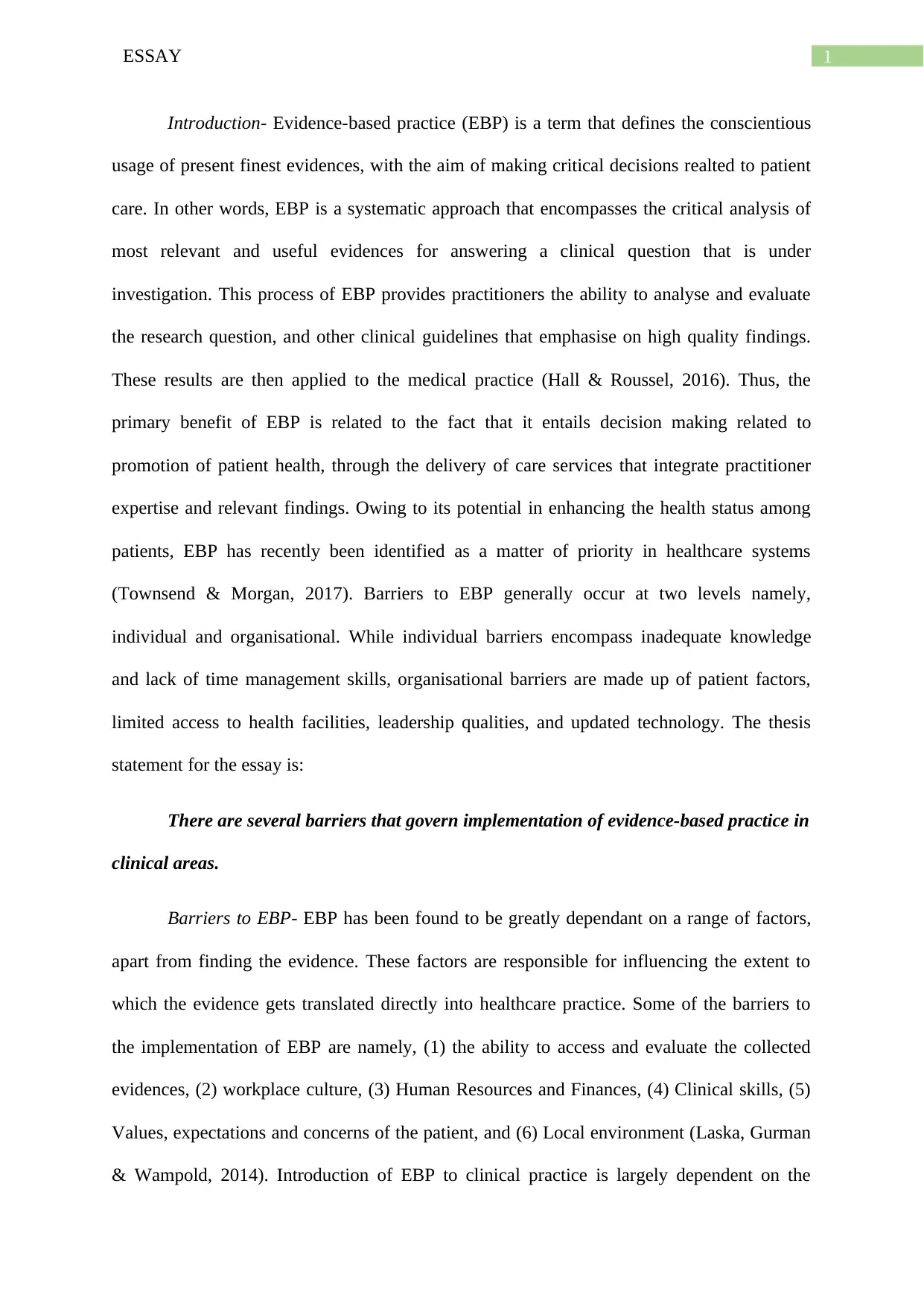
1ESSAY
Introduction- Evidence-based practice (EBP) is a term that defines the conscientious
usage of present finest evidences, with the aim of making critical decisions realted to patient
care. In other words, EBP is a systematic approach that encompasses the critical analysis of
most relevant and useful evidences for answering a clinical question that is under
investigation. This process of EBP provides practitioners the ability to analyse and evaluate
the research question, and other clinical guidelines that emphasise on high quality findings.
These results are then applied to the medical practice (Hall & Roussel, 2016). Thus, the
primary benefit of EBP is related to the fact that it entails decision making related to
promotion of patient health, through the delivery of care services that integrate practitioner
expertise and relevant findings. Owing to its potential in enhancing the health status among
patients, EBP has recently been identified as a matter of priority in healthcare systems
(Townsend & Morgan, 2017). Barriers to EBP generally occur at two levels namely,
individual and organisational. While individual barriers encompass inadequate knowledge
and lack of time management skills, organisational barriers are made up of patient factors,
limited access to health facilities, leadership qualities, and updated technology. The thesis
statement for the essay is:
There are several barriers that govern implementation of evidence-based practice in
clinical areas.
Barriers to EBP- EBP has been found to be greatly dependant on a range of factors,
apart from finding the evidence. These factors are responsible for influencing the extent to
which the evidence gets translated directly into healthcare practice. Some of the barriers to
the implementation of EBP are namely, (1) the ability to access and evaluate the collected
evidences, (2) workplace culture, (3) Human Resources and Finances, (4) Clinical skills, (5)
Values, expectations and concerns of the patient, and (6) Local environment (Laska, Gurman
& Wampold, 2014). Introduction of EBP to clinical practice is largely dependent on the
Introduction- Evidence-based practice (EBP) is a term that defines the conscientious
usage of present finest evidences, with the aim of making critical decisions realted to patient
care. In other words, EBP is a systematic approach that encompasses the critical analysis of
most relevant and useful evidences for answering a clinical question that is under
investigation. This process of EBP provides practitioners the ability to analyse and evaluate
the research question, and other clinical guidelines that emphasise on high quality findings.
These results are then applied to the medical practice (Hall & Roussel, 2016). Thus, the
primary benefit of EBP is related to the fact that it entails decision making related to
promotion of patient health, through the delivery of care services that integrate practitioner
expertise and relevant findings. Owing to its potential in enhancing the health status among
patients, EBP has recently been identified as a matter of priority in healthcare systems
(Townsend & Morgan, 2017). Barriers to EBP generally occur at two levels namely,
individual and organisational. While individual barriers encompass inadequate knowledge
and lack of time management skills, organisational barriers are made up of patient factors,
limited access to health facilities, leadership qualities, and updated technology. The thesis
statement for the essay is:
There are several barriers that govern implementation of evidence-based practice in
clinical areas.
Barriers to EBP- EBP has been found to be greatly dependant on a range of factors,
apart from finding the evidence. These factors are responsible for influencing the extent to
which the evidence gets translated directly into healthcare practice. Some of the barriers to
the implementation of EBP are namely, (1) the ability to access and evaluate the collected
evidences, (2) workplace culture, (3) Human Resources and Finances, (4) Clinical skills, (5)
Values, expectations and concerns of the patient, and (6) Local environment (Laska, Gurman
& Wampold, 2014). Introduction of EBP to clinical practice is largely dependent on the
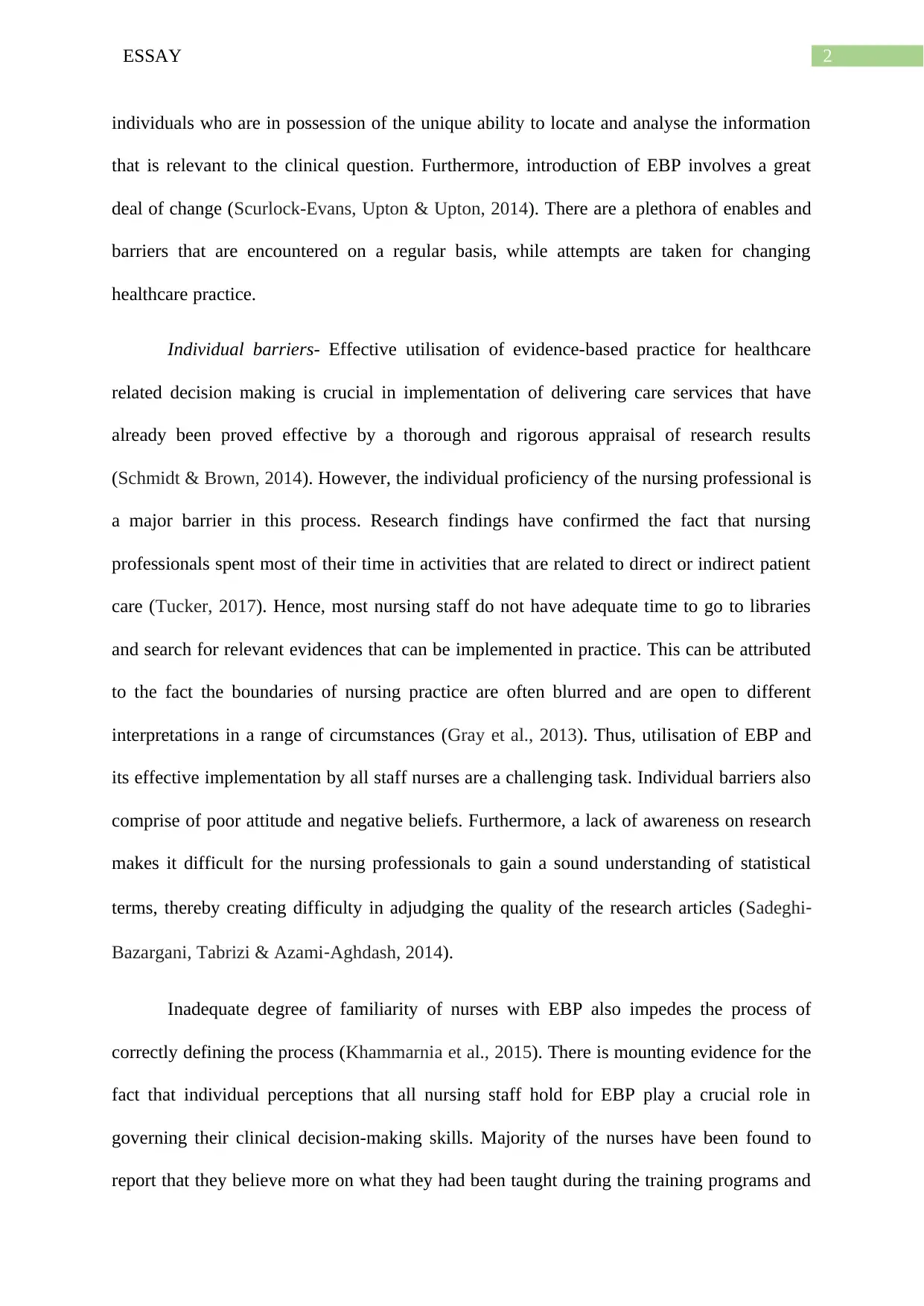
2ESSAY
individuals who are in possession of the unique ability to locate and analyse the information
that is relevant to the clinical question. Furthermore, introduction of EBP involves a great
deal of change (Scurlock-Evans, Upton & Upton, 2014). There are a plethora of enables and
barriers that are encountered on a regular basis, while attempts are taken for changing
healthcare practice.
Individual barriers- Effective utilisation of evidence-based practice for healthcare
related decision making is crucial in implementation of delivering care services that have
already been proved effective by a thorough and rigorous appraisal of research results
(Schmidt & Brown, 2014). However, the individual proficiency of the nursing professional is
a major barrier in this process. Research findings have confirmed the fact that nursing
professionals spent most of their time in activities that are related to direct or indirect patient
care (Tucker, 2017). Hence, most nursing staff do not have adequate time to go to libraries
and search for relevant evidences that can be implemented in practice. This can be attributed
to the fact the boundaries of nursing practice are often blurred and are open to different
interpretations in a range of circumstances (Gray et al., 2013). Thus, utilisation of EBP and
its effective implementation by all staff nurses are a challenging task. Individual barriers also
comprise of poor attitude and negative beliefs. Furthermore, a lack of awareness on research
makes it difficult for the nursing professionals to gain a sound understanding of statistical
terms, thereby creating difficulty in adjudging the quality of the research articles (Sadeghi‐
Bazargani, Tabrizi & Azami‐Aghdash, 2014).
Inadequate degree of familiarity of nurses with EBP also impedes the process of
correctly defining the process (Khammarnia et al., 2015). There is mounting evidence for the
fact that individual perceptions that all nursing staff hold for EBP play a crucial role in
governing their clinical decision-making skills. Majority of the nurses have been found to
report that they believe more on what they had been taught during the training programs and
individuals who are in possession of the unique ability to locate and analyse the information
that is relevant to the clinical question. Furthermore, introduction of EBP involves a great
deal of change (Scurlock-Evans, Upton & Upton, 2014). There are a plethora of enables and
barriers that are encountered on a regular basis, while attempts are taken for changing
healthcare practice.
Individual barriers- Effective utilisation of evidence-based practice for healthcare
related decision making is crucial in implementation of delivering care services that have
already been proved effective by a thorough and rigorous appraisal of research results
(Schmidt & Brown, 2014). However, the individual proficiency of the nursing professional is
a major barrier in this process. Research findings have confirmed the fact that nursing
professionals spent most of their time in activities that are related to direct or indirect patient
care (Tucker, 2017). Hence, most nursing staff do not have adequate time to go to libraries
and search for relevant evidences that can be implemented in practice. This can be attributed
to the fact the boundaries of nursing practice are often blurred and are open to different
interpretations in a range of circumstances (Gray et al., 2013). Thus, utilisation of EBP and
its effective implementation by all staff nurses are a challenging task. Individual barriers also
comprise of poor attitude and negative beliefs. Furthermore, a lack of awareness on research
makes it difficult for the nursing professionals to gain a sound understanding of statistical
terms, thereby creating difficulty in adjudging the quality of the research articles (Sadeghi‐
Bazargani, Tabrizi & Azami‐Aghdash, 2014).
Inadequate degree of familiarity of nurses with EBP also impedes the process of
correctly defining the process (Khammarnia et al., 2015). There is mounting evidence for the
fact that individual perceptions that all nursing staff hold for EBP play a crucial role in
governing their clinical decision-making skills. Majority of the nurses have been found to
report that they believe more on what they had been taught during the training programs and
⊘ This is a preview!⊘
Do you want full access?
Subscribe today to unlock all pages.

Trusted by 1+ million students worldwide
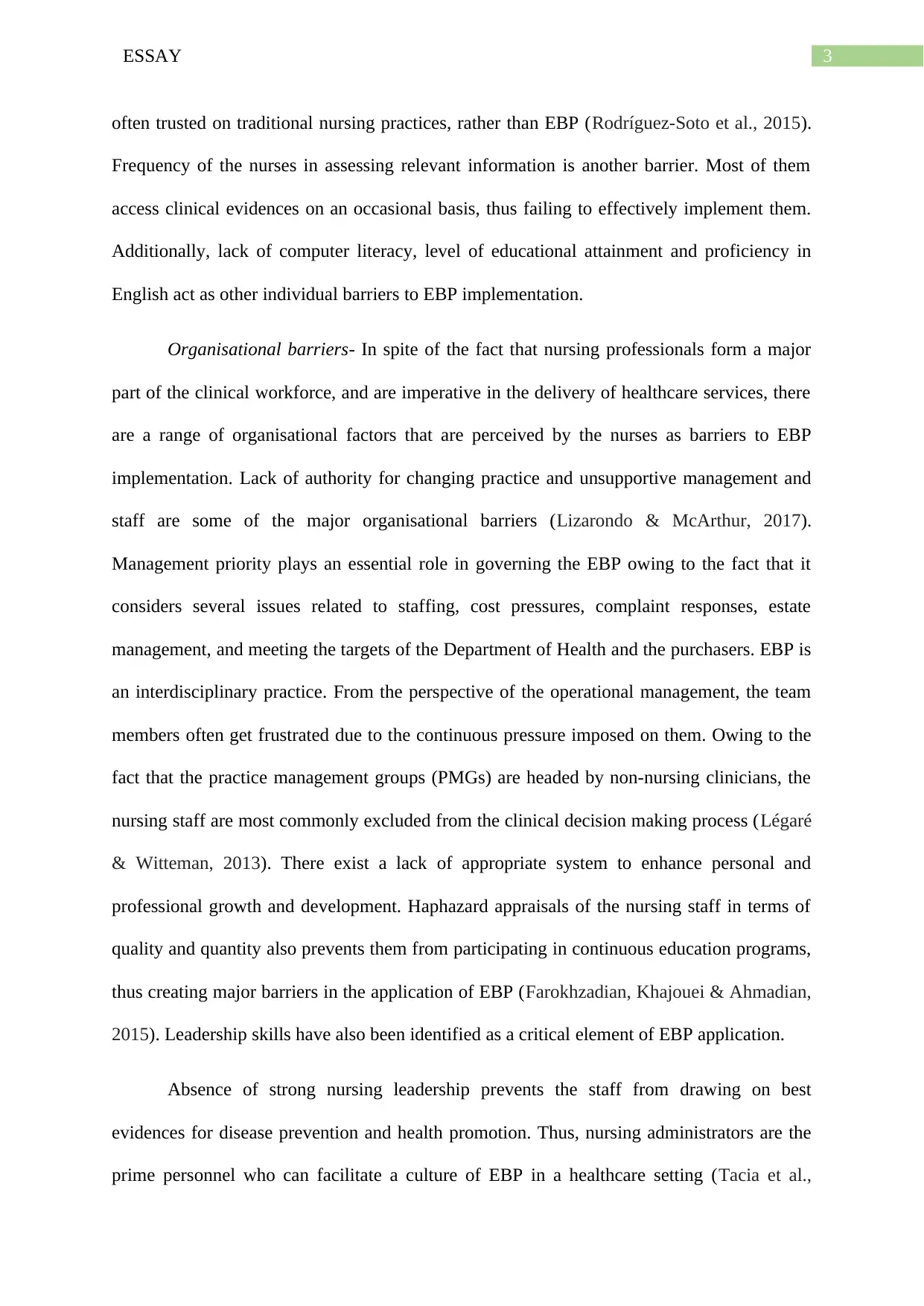
3ESSAY
often trusted on traditional nursing practices, rather than EBP (Rodríguez-Soto et al., 2015).
Frequency of the nurses in assessing relevant information is another barrier. Most of them
access clinical evidences on an occasional basis, thus failing to effectively implement them.
Additionally, lack of computer literacy, level of educational attainment and proficiency in
English act as other individual barriers to EBP implementation.
Organisational barriers- In spite of the fact that nursing professionals form a major
part of the clinical workforce, and are imperative in the delivery of healthcare services, there
are a range of organisational factors that are perceived by the nurses as barriers to EBP
implementation. Lack of authority for changing practice and unsupportive management and
staff are some of the major organisational barriers (Lizarondo & McArthur, 2017).
Management priority plays an essential role in governing the EBP owing to the fact that it
considers several issues related to staffing, cost pressures, complaint responses, estate
management, and meeting the targets of the Department of Health and the purchasers. EBP is
an interdisciplinary practice. From the perspective of the operational management, the team
members often get frustrated due to the continuous pressure imposed on them. Owing to the
fact that the practice management groups (PMGs) are headed by non-nursing clinicians, the
nursing staff are most commonly excluded from the clinical decision making process (Légaré
& Witteman, 2013). There exist a lack of appropriate system to enhance personal and
professional growth and development. Haphazard appraisals of the nursing staff in terms of
quality and quantity also prevents them from participating in continuous education programs,
thus creating major barriers in the application of EBP (Farokhzadian, Khajouei & Ahmadian,
2015). Leadership skills have also been identified as a critical element of EBP application.
Absence of strong nursing leadership prevents the staff from drawing on best
evidences for disease prevention and health promotion. Thus, nursing administrators are the
prime personnel who can facilitate a culture of EBP in a healthcare setting (Tacia et al.,
often trusted on traditional nursing practices, rather than EBP (Rodríguez-Soto et al., 2015).
Frequency of the nurses in assessing relevant information is another barrier. Most of them
access clinical evidences on an occasional basis, thus failing to effectively implement them.
Additionally, lack of computer literacy, level of educational attainment and proficiency in
English act as other individual barriers to EBP implementation.
Organisational barriers- In spite of the fact that nursing professionals form a major
part of the clinical workforce, and are imperative in the delivery of healthcare services, there
are a range of organisational factors that are perceived by the nurses as barriers to EBP
implementation. Lack of authority for changing practice and unsupportive management and
staff are some of the major organisational barriers (Lizarondo & McArthur, 2017).
Management priority plays an essential role in governing the EBP owing to the fact that it
considers several issues related to staffing, cost pressures, complaint responses, estate
management, and meeting the targets of the Department of Health and the purchasers. EBP is
an interdisciplinary practice. From the perspective of the operational management, the team
members often get frustrated due to the continuous pressure imposed on them. Owing to the
fact that the practice management groups (PMGs) are headed by non-nursing clinicians, the
nursing staff are most commonly excluded from the clinical decision making process (Légaré
& Witteman, 2013). There exist a lack of appropriate system to enhance personal and
professional growth and development. Haphazard appraisals of the nursing staff in terms of
quality and quantity also prevents them from participating in continuous education programs,
thus creating major barriers in the application of EBP (Farokhzadian, Khajouei & Ahmadian,
2015). Leadership skills have also been identified as a critical element of EBP application.
Absence of strong nursing leadership prevents the staff from drawing on best
evidences for disease prevention and health promotion. Thus, nursing administrators are the
prime personnel who can facilitate a culture of EBP in a healthcare setting (Tacia et al.,
Paraphrase This Document
Need a fresh take? Get an instant paraphrase of this document with our AI Paraphraser
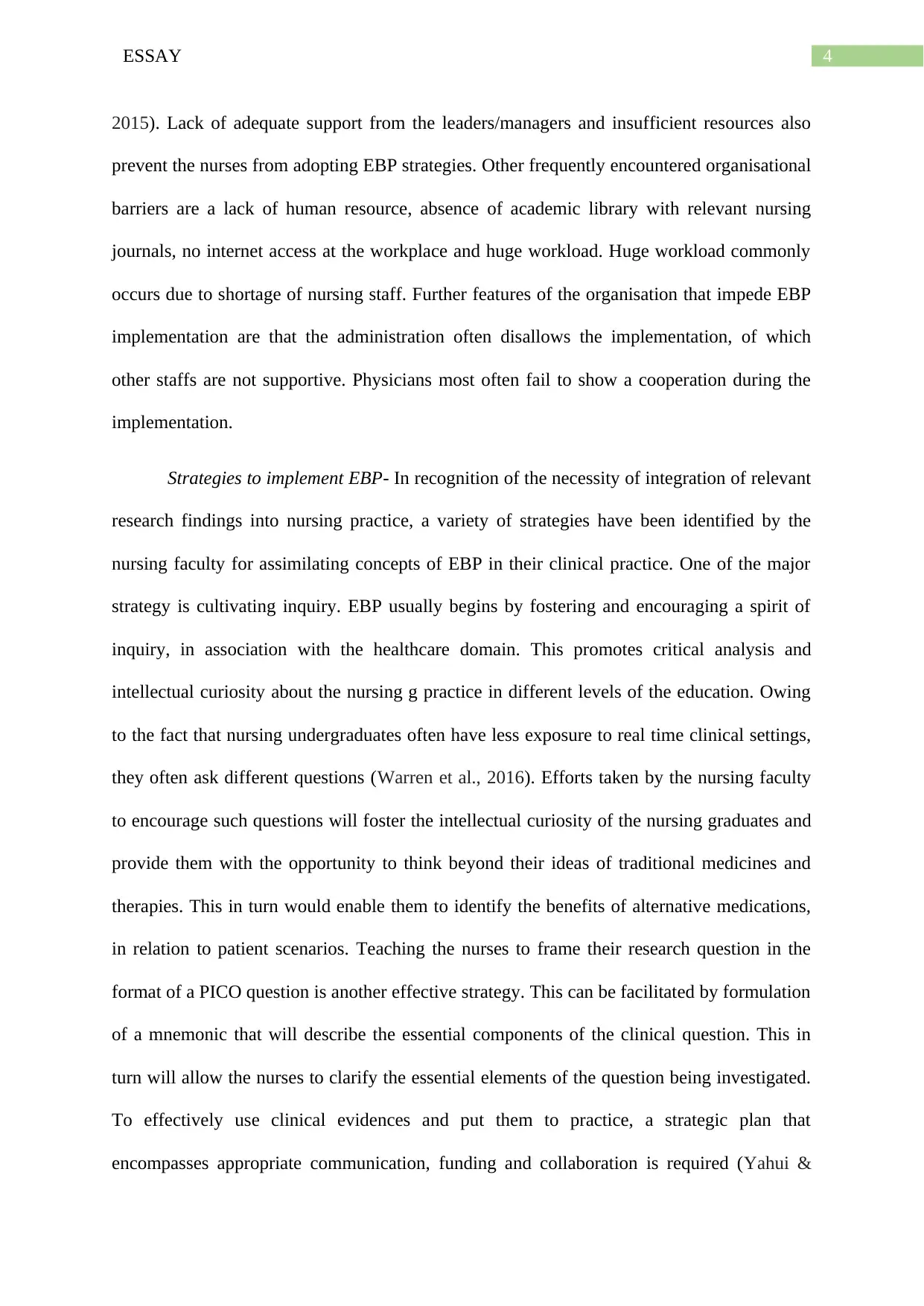
4ESSAY
2015). Lack of adequate support from the leaders/managers and insufficient resources also
prevent the nurses from adopting EBP strategies. Other frequently encountered organisational
barriers are a lack of human resource, absence of academic library with relevant nursing
journals, no internet access at the workplace and huge workload. Huge workload commonly
occurs due to shortage of nursing staff. Further features of the organisation that impede EBP
implementation are that the administration often disallows the implementation, of which
other staffs are not supportive. Physicians most often fail to show a cooperation during the
implementation.
Strategies to implement EBP- In recognition of the necessity of integration of relevant
research findings into nursing practice, a variety of strategies have been identified by the
nursing faculty for assimilating concepts of EBP in their clinical practice. One of the major
strategy is cultivating inquiry. EBP usually begins by fostering and encouraging a spirit of
inquiry, in association with the healthcare domain. This promotes critical analysis and
intellectual curiosity about the nursing g practice in different levels of the education. Owing
to the fact that nursing undergraduates often have less exposure to real time clinical settings,
they often ask different questions (Warren et al., 2016). Efforts taken by the nursing faculty
to encourage such questions will foster the intellectual curiosity of the nursing graduates and
provide them with the opportunity to think beyond their ideas of traditional medicines and
therapies. This in turn would enable them to identify the benefits of alternative medications,
in relation to patient scenarios. Teaching the nurses to frame their research question in the
format of a PICO question is another effective strategy. This can be facilitated by formulation
of a mnemonic that will describe the essential components of the clinical question. This in
turn will allow the nurses to clarify the essential elements of the question being investigated.
To effectively use clinical evidences and put them to practice, a strategic plan that
encompasses appropriate communication, funding and collaboration is required (Yahui &
2015). Lack of adequate support from the leaders/managers and insufficient resources also
prevent the nurses from adopting EBP strategies. Other frequently encountered organisational
barriers are a lack of human resource, absence of academic library with relevant nursing
journals, no internet access at the workplace and huge workload. Huge workload commonly
occurs due to shortage of nursing staff. Further features of the organisation that impede EBP
implementation are that the administration often disallows the implementation, of which
other staffs are not supportive. Physicians most often fail to show a cooperation during the
implementation.
Strategies to implement EBP- In recognition of the necessity of integration of relevant
research findings into nursing practice, a variety of strategies have been identified by the
nursing faculty for assimilating concepts of EBP in their clinical practice. One of the major
strategy is cultivating inquiry. EBP usually begins by fostering and encouraging a spirit of
inquiry, in association with the healthcare domain. This promotes critical analysis and
intellectual curiosity about the nursing g practice in different levels of the education. Owing
to the fact that nursing undergraduates often have less exposure to real time clinical settings,
they often ask different questions (Warren et al., 2016). Efforts taken by the nursing faculty
to encourage such questions will foster the intellectual curiosity of the nursing graduates and
provide them with the opportunity to think beyond their ideas of traditional medicines and
therapies. This in turn would enable them to identify the benefits of alternative medications,
in relation to patient scenarios. Teaching the nurses to frame their research question in the
format of a PICO question is another effective strategy. This can be facilitated by formulation
of a mnemonic that will describe the essential components of the clinical question. This in
turn will allow the nurses to clarify the essential elements of the question being investigated.
To effectively use clinical evidences and put them to practice, a strategic plan that
encompasses appropriate communication, funding and collaboration is required (Yahui &
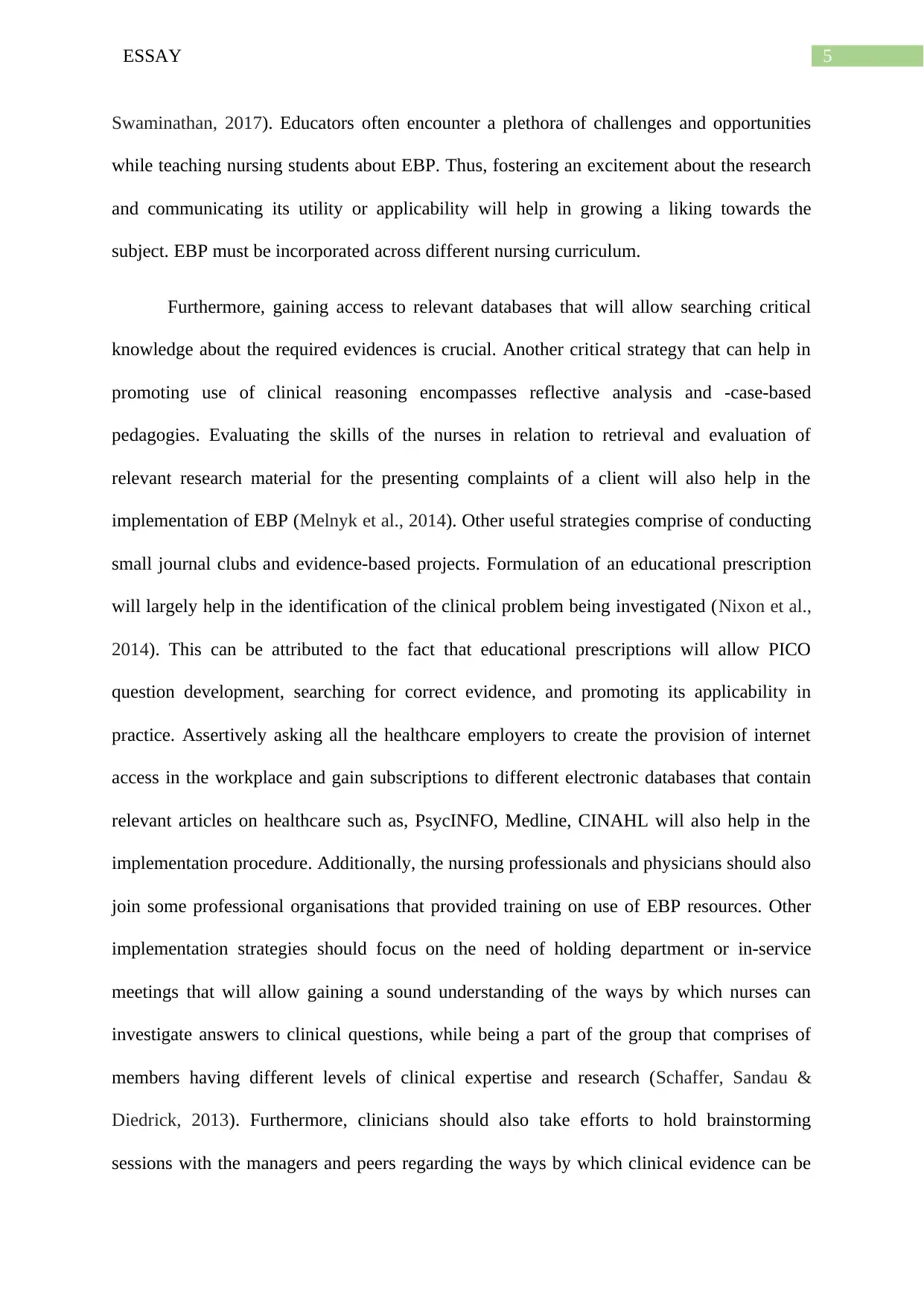
5ESSAY
Swaminathan, 2017). Educators often encounter a plethora of challenges and opportunities
while teaching nursing students about EBP. Thus, fostering an excitement about the research
and communicating its utility or applicability will help in growing a liking towards the
subject. EBP must be incorporated across different nursing curriculum.
Furthermore, gaining access to relevant databases that will allow searching critical
knowledge about the required evidences is crucial. Another critical strategy that can help in
promoting use of clinical reasoning encompasses reflective analysis and -case-based
pedagogies. Evaluating the skills of the nurses in relation to retrieval and evaluation of
relevant research material for the presenting complaints of a client will also help in the
implementation of EBP (Melnyk et al., 2014). Other useful strategies comprise of conducting
small journal clubs and evidence-based projects. Formulation of an educational prescription
will largely help in the identification of the clinical problem being investigated (Nixon et al.,
2014). This can be attributed to the fact that educational prescriptions will allow PICO
question development, searching for correct evidence, and promoting its applicability in
practice. Assertively asking all the healthcare employers to create the provision of internet
access in the workplace and gain subscriptions to different electronic databases that contain
relevant articles on healthcare such as, PsycINFO, Medline, CINAHL will also help in the
implementation procedure. Additionally, the nursing professionals and physicians should also
join some professional organisations that provided training on use of EBP resources. Other
implementation strategies should focus on the need of holding department or in-service
meetings that will allow gaining a sound understanding of the ways by which nurses can
investigate answers to clinical questions, while being a part of the group that comprises of
members having different levels of clinical expertise and research (Schaffer, Sandau &
Diedrick, 2013). Furthermore, clinicians should also take efforts to hold brainstorming
sessions with the managers and peers regarding the ways by which clinical evidence can be
Swaminathan, 2017). Educators often encounter a plethora of challenges and opportunities
while teaching nursing students about EBP. Thus, fostering an excitement about the research
and communicating its utility or applicability will help in growing a liking towards the
subject. EBP must be incorporated across different nursing curriculum.
Furthermore, gaining access to relevant databases that will allow searching critical
knowledge about the required evidences is crucial. Another critical strategy that can help in
promoting use of clinical reasoning encompasses reflective analysis and -case-based
pedagogies. Evaluating the skills of the nurses in relation to retrieval and evaluation of
relevant research material for the presenting complaints of a client will also help in the
implementation of EBP (Melnyk et al., 2014). Other useful strategies comprise of conducting
small journal clubs and evidence-based projects. Formulation of an educational prescription
will largely help in the identification of the clinical problem being investigated (Nixon et al.,
2014). This can be attributed to the fact that educational prescriptions will allow PICO
question development, searching for correct evidence, and promoting its applicability in
practice. Assertively asking all the healthcare employers to create the provision of internet
access in the workplace and gain subscriptions to different electronic databases that contain
relevant articles on healthcare such as, PsycINFO, Medline, CINAHL will also help in the
implementation procedure. Additionally, the nursing professionals and physicians should also
join some professional organisations that provided training on use of EBP resources. Other
implementation strategies should focus on the need of holding department or in-service
meetings that will allow gaining a sound understanding of the ways by which nurses can
investigate answers to clinical questions, while being a part of the group that comprises of
members having different levels of clinical expertise and research (Schaffer, Sandau &
Diedrick, 2013). Furthermore, clinicians should also take efforts to hold brainstorming
sessions with the managers and peers regarding the ways by which clinical evidence can be
⊘ This is a preview!⊘
Do you want full access?
Subscribe today to unlock all pages.

Trusted by 1+ million students worldwide
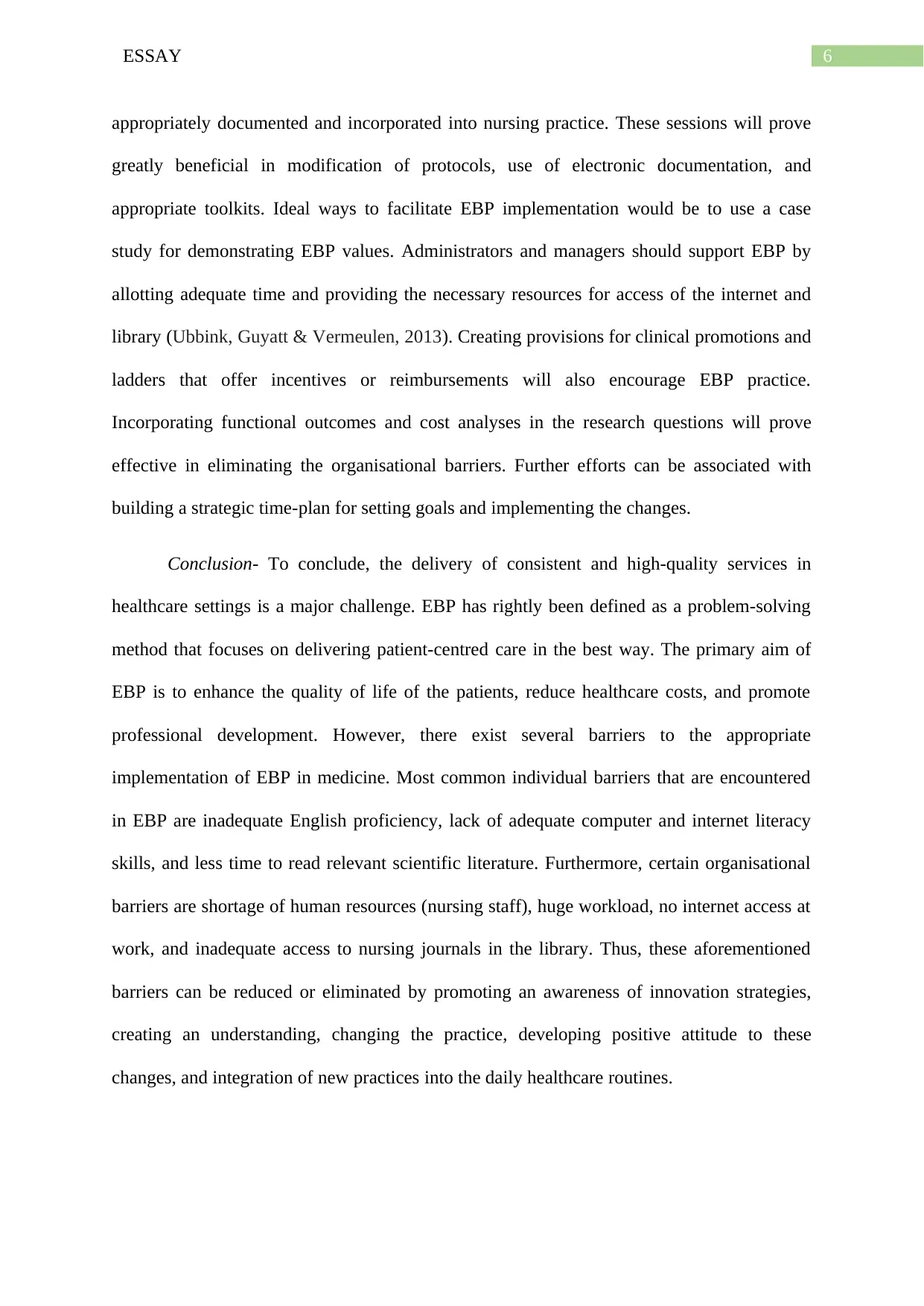
6ESSAY
appropriately documented and incorporated into nursing practice. These sessions will prove
greatly beneficial in modification of protocols, use of electronic documentation, and
appropriate toolkits. Ideal ways to facilitate EBP implementation would be to use a case
study for demonstrating EBP values. Administrators and managers should support EBP by
allotting adequate time and providing the necessary resources for access of the internet and
library (Ubbink, Guyatt & Vermeulen, 2013). Creating provisions for clinical promotions and
ladders that offer incentives or reimbursements will also encourage EBP practice.
Incorporating functional outcomes and cost analyses in the research questions will prove
effective in eliminating the organisational barriers. Further efforts can be associated with
building a strategic time-plan for setting goals and implementing the changes.
Conclusion- To conclude, the delivery of consistent and high-quality services in
healthcare settings is a major challenge. EBP has rightly been defined as a problem-solving
method that focuses on delivering patient-centred care in the best way. The primary aim of
EBP is to enhance the quality of life of the patients, reduce healthcare costs, and promote
professional development. However, there exist several barriers to the appropriate
implementation of EBP in medicine. Most common individual barriers that are encountered
in EBP are inadequate English proficiency, lack of adequate computer and internet literacy
skills, and less time to read relevant scientific literature. Furthermore, certain organisational
barriers are shortage of human resources (nursing staff), huge workload, no internet access at
work, and inadequate access to nursing journals in the library. Thus, these aforementioned
barriers can be reduced or eliminated by promoting an awareness of innovation strategies,
creating an understanding, changing the practice, developing positive attitude to these
changes, and integration of new practices into the daily healthcare routines.
appropriately documented and incorporated into nursing practice. These sessions will prove
greatly beneficial in modification of protocols, use of electronic documentation, and
appropriate toolkits. Ideal ways to facilitate EBP implementation would be to use a case
study for demonstrating EBP values. Administrators and managers should support EBP by
allotting adequate time and providing the necessary resources for access of the internet and
library (Ubbink, Guyatt & Vermeulen, 2013). Creating provisions for clinical promotions and
ladders that offer incentives or reimbursements will also encourage EBP practice.
Incorporating functional outcomes and cost analyses in the research questions will prove
effective in eliminating the organisational barriers. Further efforts can be associated with
building a strategic time-plan for setting goals and implementing the changes.
Conclusion- To conclude, the delivery of consistent and high-quality services in
healthcare settings is a major challenge. EBP has rightly been defined as a problem-solving
method that focuses on delivering patient-centred care in the best way. The primary aim of
EBP is to enhance the quality of life of the patients, reduce healthcare costs, and promote
professional development. However, there exist several barriers to the appropriate
implementation of EBP in medicine. Most common individual barriers that are encountered
in EBP are inadequate English proficiency, lack of adequate computer and internet literacy
skills, and less time to read relevant scientific literature. Furthermore, certain organisational
barriers are shortage of human resources (nursing staff), huge workload, no internet access at
work, and inadequate access to nursing journals in the library. Thus, these aforementioned
barriers can be reduced or eliminated by promoting an awareness of innovation strategies,
creating an understanding, changing the practice, developing positive attitude to these
changes, and integration of new practices into the daily healthcare routines.
Paraphrase This Document
Need a fresh take? Get an instant paraphrase of this document with our AI Paraphraser

7ESSAY
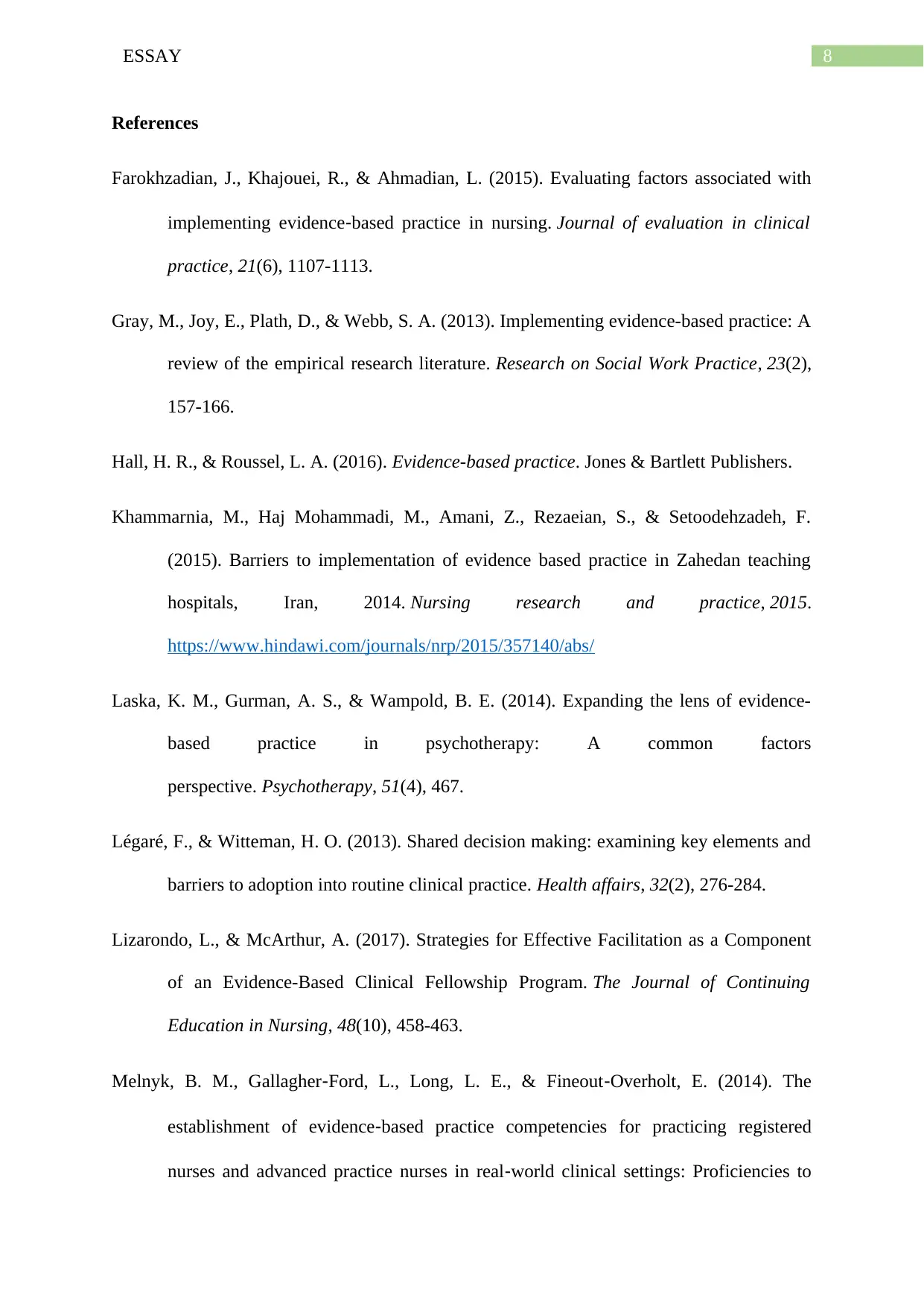
8ESSAY
References
Farokhzadian, J., Khajouei, R., & Ahmadian, L. (2015). Evaluating factors associated with
implementing evidence‐based practice in nursing. Journal of evaluation in clinical
practice, 21(6), 1107-1113.
Gray, M., Joy, E., Plath, D., & Webb, S. A. (2013). Implementing evidence-based practice: A
review of the empirical research literature. Research on Social Work Practice, 23(2),
157-166.
Hall, H. R., & Roussel, L. A. (2016). Evidence-based practice. Jones & Bartlett Publishers.
Khammarnia, M., Haj Mohammadi, M., Amani, Z., Rezaeian, S., & Setoodehzadeh, F.
(2015). Barriers to implementation of evidence based practice in Zahedan teaching
hospitals, Iran, 2014. Nursing research and practice, 2015.
https://www.hindawi.com/journals/nrp/2015/357140/abs/
Laska, K. M., Gurman, A. S., & Wampold, B. E. (2014). Expanding the lens of evidence-
based practice in psychotherapy: A common factors
perspective. Psychotherapy, 51(4), 467.
Légaré, F., & Witteman, H. O. (2013). Shared decision making: examining key elements and
barriers to adoption into routine clinical practice. Health affairs, 32(2), 276-284.
Lizarondo, L., & McArthur, A. (2017). Strategies for Effective Facilitation as a Component
of an Evidence-Based Clinical Fellowship Program. The Journal of Continuing
Education in Nursing, 48(10), 458-463.
Melnyk, B. M., Gallagher‐Ford, L., Long, L. E., & Fineout‐Overholt, E. (2014). The
establishment of evidence‐based practice competencies for practicing registered
nurses and advanced practice nurses in real‐world clinical settings: Proficiencies to
References
Farokhzadian, J., Khajouei, R., & Ahmadian, L. (2015). Evaluating factors associated with
implementing evidence‐based practice in nursing. Journal of evaluation in clinical
practice, 21(6), 1107-1113.
Gray, M., Joy, E., Plath, D., & Webb, S. A. (2013). Implementing evidence-based practice: A
review of the empirical research literature. Research on Social Work Practice, 23(2),
157-166.
Hall, H. R., & Roussel, L. A. (2016). Evidence-based practice. Jones & Bartlett Publishers.
Khammarnia, M., Haj Mohammadi, M., Amani, Z., Rezaeian, S., & Setoodehzadeh, F.
(2015). Barriers to implementation of evidence based practice in Zahedan teaching
hospitals, Iran, 2014. Nursing research and practice, 2015.
https://www.hindawi.com/journals/nrp/2015/357140/abs/
Laska, K. M., Gurman, A. S., & Wampold, B. E. (2014). Expanding the lens of evidence-
based practice in psychotherapy: A common factors
perspective. Psychotherapy, 51(4), 467.
Légaré, F., & Witteman, H. O. (2013). Shared decision making: examining key elements and
barriers to adoption into routine clinical practice. Health affairs, 32(2), 276-284.
Lizarondo, L., & McArthur, A. (2017). Strategies for Effective Facilitation as a Component
of an Evidence-Based Clinical Fellowship Program. The Journal of Continuing
Education in Nursing, 48(10), 458-463.
Melnyk, B. M., Gallagher‐Ford, L., Long, L. E., & Fineout‐Overholt, E. (2014). The
establishment of evidence‐based practice competencies for practicing registered
nurses and advanced practice nurses in real‐world clinical settings: Proficiencies to
⊘ This is a preview!⊘
Do you want full access?
Subscribe today to unlock all pages.

Trusted by 1+ million students worldwide
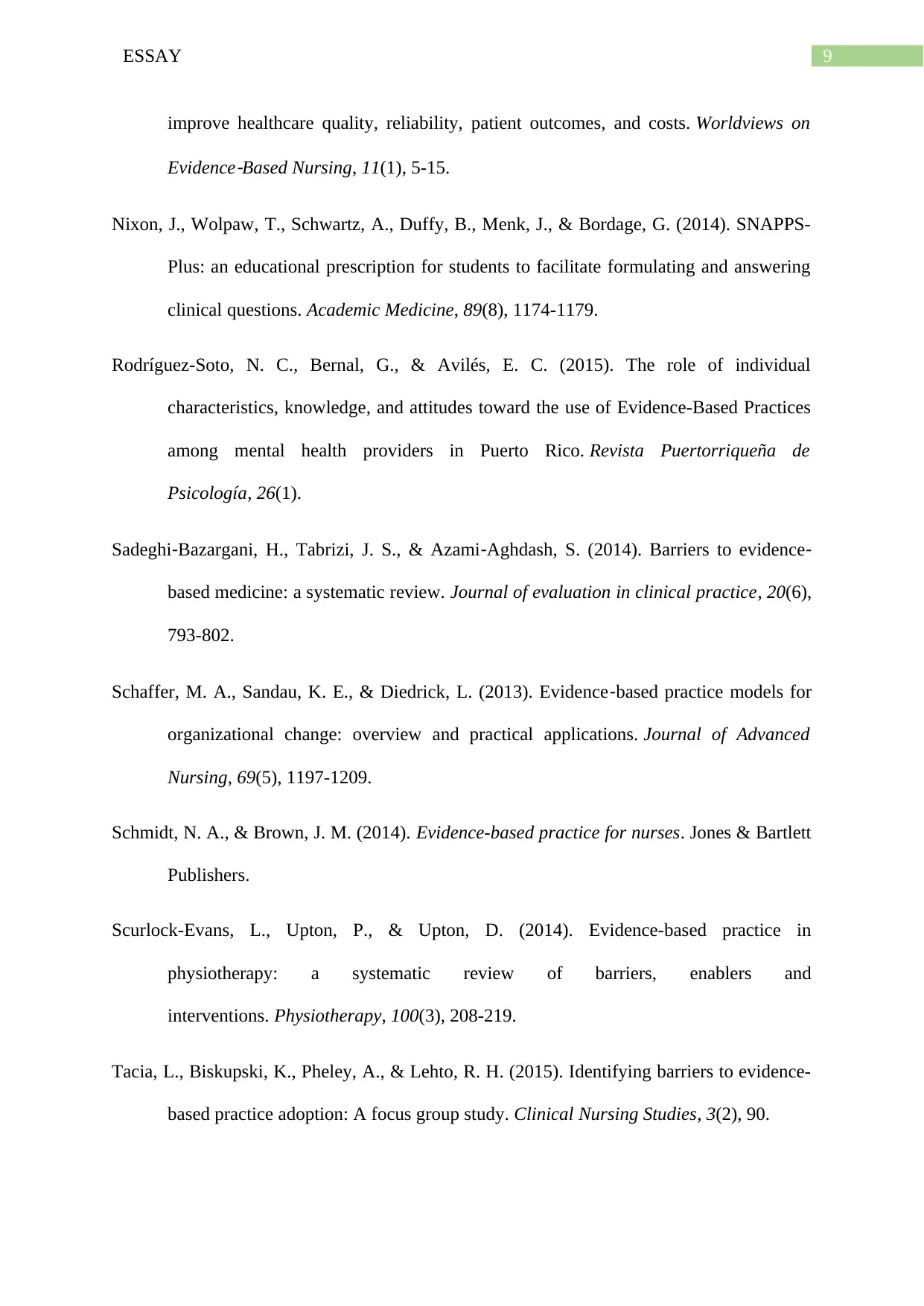
9ESSAY
improve healthcare quality, reliability, patient outcomes, and costs. Worldviews on
Evidence
‐Based Nursing, 11(1), 5-15.
Nixon, J., Wolpaw, T., Schwartz, A., Duffy, B., Menk, J., & Bordage, G. (2014). SNAPPS-
Plus: an educational prescription for students to facilitate formulating and answering
clinical questions. Academic Medicine, 89(8), 1174-1179.
Rodríguez-Soto, N. C., Bernal, G., & Avilés, E. C. (2015). The role of individual
characteristics, knowledge, and attitudes toward the use of Evidence-Based Practices
among mental health providers in Puerto Rico. Revista Puertorriqueña de
Psicología, 26(1).
Sadeghi‐Bazargani, H., Tabrizi, J. S., & Azami‐Aghdash, S. (2014). Barriers to evidence‐
based medicine: a systematic review. Journal of evaluation in clinical practice, 20(6),
793-802.
Schaffer, M. A., Sandau, K. E., & Diedrick, L. (2013). Evidence‐based practice models for
organizational change: overview and practical applications. Journal of Advanced
Nursing, 69(5), 1197-1209.
Schmidt, N. A., & Brown, J. M. (2014). Evidence-based practice for nurses. Jones & Bartlett
Publishers.
Scurlock-Evans, L., Upton, P., & Upton, D. (2014). Evidence-based practice in
physiotherapy: a systematic review of barriers, enablers and
interventions. Physiotherapy, 100(3), 208-219.
Tacia, L., Biskupski, K., Pheley, A., & Lehto, R. H. (2015). Identifying barriers to evidence-
based practice adoption: A focus group study. Clinical Nursing Studies, 3(2), 90.
improve healthcare quality, reliability, patient outcomes, and costs. Worldviews on
Evidence
‐Based Nursing, 11(1), 5-15.
Nixon, J., Wolpaw, T., Schwartz, A., Duffy, B., Menk, J., & Bordage, G. (2014). SNAPPS-
Plus: an educational prescription for students to facilitate formulating and answering
clinical questions. Academic Medicine, 89(8), 1174-1179.
Rodríguez-Soto, N. C., Bernal, G., & Avilés, E. C. (2015). The role of individual
characteristics, knowledge, and attitudes toward the use of Evidence-Based Practices
among mental health providers in Puerto Rico. Revista Puertorriqueña de
Psicología, 26(1).
Sadeghi‐Bazargani, H., Tabrizi, J. S., & Azami‐Aghdash, S. (2014). Barriers to evidence‐
based medicine: a systematic review. Journal of evaluation in clinical practice, 20(6),
793-802.
Schaffer, M. A., Sandau, K. E., & Diedrick, L. (2013). Evidence‐based practice models for
organizational change: overview and practical applications. Journal of Advanced
Nursing, 69(5), 1197-1209.
Schmidt, N. A., & Brown, J. M. (2014). Evidence-based practice for nurses. Jones & Bartlett
Publishers.
Scurlock-Evans, L., Upton, P., & Upton, D. (2014). Evidence-based practice in
physiotherapy: a systematic review of barriers, enablers and
interventions. Physiotherapy, 100(3), 208-219.
Tacia, L., Biskupski, K., Pheley, A., & Lehto, R. H. (2015). Identifying barriers to evidence-
based practice adoption: A focus group study. Clinical Nursing Studies, 3(2), 90.
Paraphrase This Document
Need a fresh take? Get an instant paraphrase of this document with our AI Paraphraser
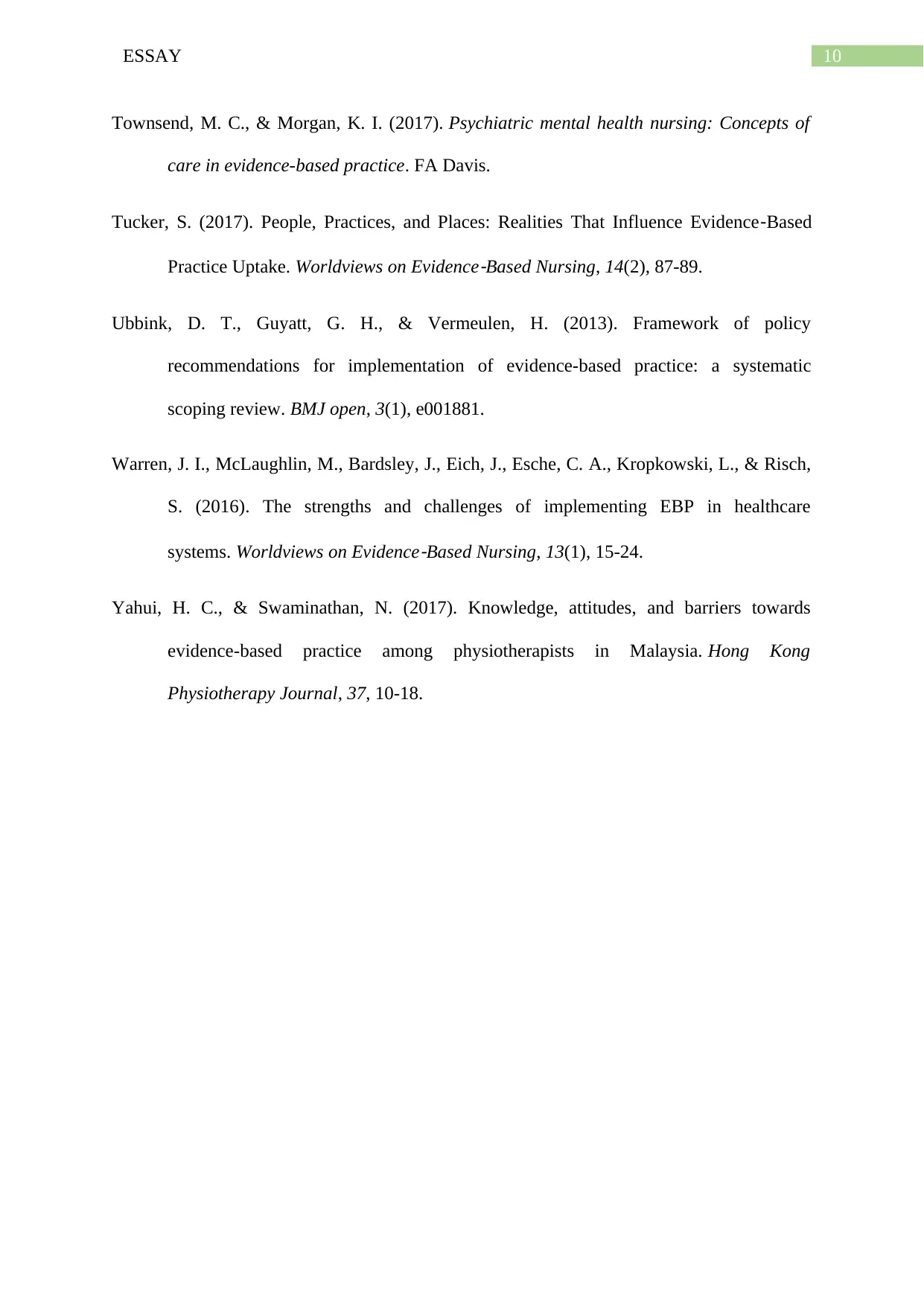
10ESSAY
Townsend, M. C., & Morgan, K. I. (2017). Psychiatric mental health nursing: Concepts of
care in evidence-based practice. FA Davis.
Tucker, S. (2017). People, Practices, and Places: Realities That Influence Evidence‐Based
Practice Uptake. Worldviews on Evidence
‐Based Nursing, 14(2), 87-89.
Ubbink, D. T., Guyatt, G. H., & Vermeulen, H. (2013). Framework of policy
recommendations for implementation of evidence-based practice: a systematic
scoping review. BMJ open, 3(1), e001881.
Warren, J. I., McLaughlin, M., Bardsley, J., Eich, J., Esche, C. A., Kropkowski, L., & Risch,
S. (2016). The strengths and challenges of implementing EBP in healthcare
systems. Worldviews on Evidence
‐Based Nursing, 13(1), 15-24.
Yahui, H. C., & Swaminathan, N. (2017). Knowledge, attitudes, and barriers towards
evidence-based practice among physiotherapists in Malaysia. Hong Kong
Physiotherapy Journal, 37, 10-18.
Townsend, M. C., & Morgan, K. I. (2017). Psychiatric mental health nursing: Concepts of
care in evidence-based practice. FA Davis.
Tucker, S. (2017). People, Practices, and Places: Realities That Influence Evidence‐Based
Practice Uptake. Worldviews on Evidence
‐Based Nursing, 14(2), 87-89.
Ubbink, D. T., Guyatt, G. H., & Vermeulen, H. (2013). Framework of policy
recommendations for implementation of evidence-based practice: a systematic
scoping review. BMJ open, 3(1), e001881.
Warren, J. I., McLaughlin, M., Bardsley, J., Eich, J., Esche, C. A., Kropkowski, L., & Risch,
S. (2016). The strengths and challenges of implementing EBP in healthcare
systems. Worldviews on Evidence
‐Based Nursing, 13(1), 15-24.
Yahui, H. C., & Swaminathan, N. (2017). Knowledge, attitudes, and barriers towards
evidence-based practice among physiotherapists in Malaysia. Hong Kong
Physiotherapy Journal, 37, 10-18.
1 out of 11
Related Documents
Your All-in-One AI-Powered Toolkit for Academic Success.
+13062052269
info@desklib.com
Available 24*7 on WhatsApp / Email
![[object Object]](/_next/static/media/star-bottom.7253800d.svg)
Unlock your academic potential
Copyright © 2020–2025 A2Z Services. All Rights Reserved. Developed and managed by ZUCOL.





